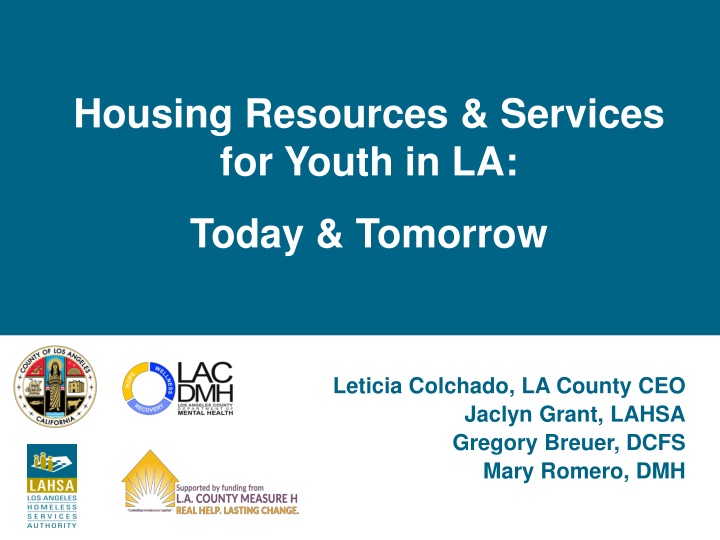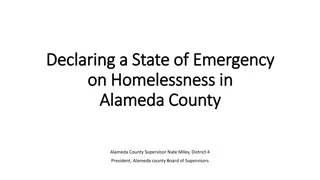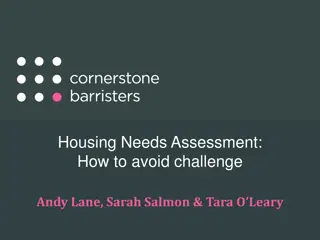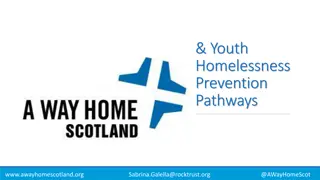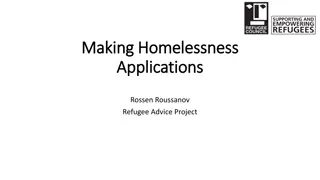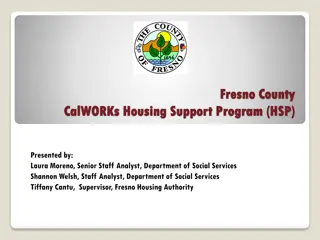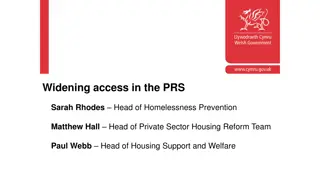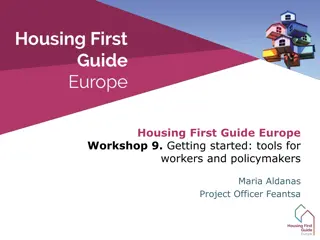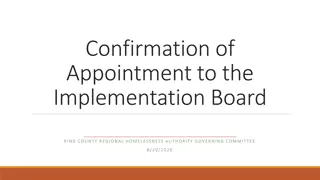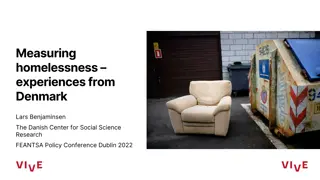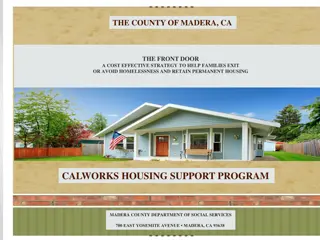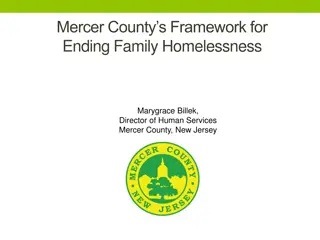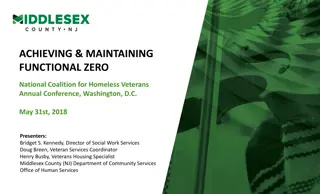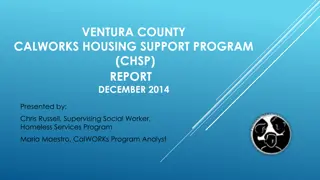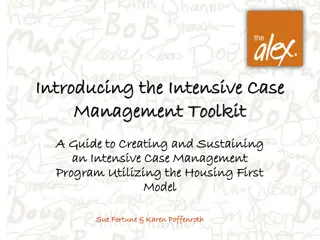Combating Homelessness: LA County's Youth Housing Initiative
LA County has undertaken a multi-faceted approach to combat youth homelessness through initiatives like the Homeless Initiative and Measure H. Strategies include preventing homelessness, rapid rehousing, and enhancing services for transition-age youth. The focus is on collaboration, investing in proven strategies, and securing ongoing funding. The Coordinated Entry System brings together resources to connect homeless youth with services effectively.
Download Presentation

Please find below an Image/Link to download the presentation.
The content on the website is provided AS IS for your information and personal use only. It may not be sold, licensed, or shared on other websites without obtaining consent from the author.If you encounter any issues during the download, it is possible that the publisher has removed the file from their server.
You are allowed to download the files provided on this website for personal or commercial use, subject to the condition that they are used lawfully. All files are the property of their respective owners.
The content on the website is provided AS IS for your information and personal use only. It may not be sold, licensed, or shared on other websites without obtaining consent from the author.
E N D
Presentation Transcript
Housing Resources & Services for Youth in LA: Today & Tomorrow Leticia Colchado, LA County CEO Jaclyn Grant, LAHSA Gregory Breuer, DCFS Mary Romero, DMH
Todays Adventure Homeless Initiative & Measure H Youth Coordinated Entry System (YCES) DCFS Youth Housing Resources DMH Youth Housing Resources Q&A
Homeless Initiative & Measure H Seizing the Moment: Historic opportunity to combat homelessness throughout LA County Launched in August 2015 Initial Charge of developing a comprehensive set of recommended County Strategies to combat homelessness HI lead an Inclusive and Collaborative process involving over 1,100 experts and community members focused on what works 18 Policy Summits and 4 Focus Groups identified the key issues impacting homelessness and resulting strategies. Initial plan did not include carve-outs for special populations 12/15/15 - Board adopted motion identifying Transition Age Youth as a priority population and directed CEO to allocate $5 Million of initial HI funding to Enhance Services for Transition Age Youth
Homeless Initiative & Measure H On February 9, 2016, the Board of Supervisors adopted a coordinated set of 47 strategies to combat homelessness, including strategies in which cities, businesses and faith leaders can participate New one-time funding approved: $99.7 million Key Principles Guiding Strategies Collaboration among County, Cities, and Community Partners Investing in Proven Strategies Leveraging mainstream health, social services and criminal just systems Seamless, client-centered services Ongoing Funding Secured through Measure H $355 Million per year for 10 years 4 New Strategies Added
Homeless Initiative & Measure H 51 strategies covering 6 areas, 3 of which include youth focus: Prevent Homelessness Strategy A4- Prevent discharges from Foster Care and Probation Subsidize Housing Strategy B3 Rapid Rehousing for Youth Strategy B7 Interim and Bridge Housing for those Exiting Institutions Create a Coordinated System Strategy E7 Strengthen the Coordinated Entry System Strategy E8 Enhance the Emergency Shelter System Strategy E14 Enhanced Services for Transition Age Youth
Coordinated Entry System (CES) A countywide system that brings together new and existing resources to connect people experiencing homelessness with housing and services in alignment with individual needs
Coordinated Entry System (CES) To create a system that is more: Families Effective Efficient Fair Coordinated Entry System Adults for everyone experiencing homelessness Youth
I. Definition of TAY in Los Angeles County Transition Age Youth (TAY) refers to individuals who are between the ages of 16-25 years old. The TAY System of Care (TAY-SOC) Bureau of the Los Angeles County Department of Mental Health (DMH) provides an array of mental health and supportive services for Seriously Emotionally Disturbed (SED) and Severe and Persistently Mentally Ill (SPMI) TAY. Some of the priority populations include the following: - TAY struggling with substance abuse issues - TAY who are homeless or at-risk of homelessness - TAY aging out of the children s mental health, child welfare, or juvenile justice systems - TAY leaving long-term institutional care - TAY experiencing their first episode of major mental illness
TAY Navigation and Housing Specialist Teams TAY Navigator Master s level clinician. Conduct brief screenings to assess mental health and housing needs, and provide linkages and referrals to appropriate services and supports. Participate in MHSA outreach presentations in collaboration with Service Area staff, Outreach Specialists, and FSP providers to promote knowledge about MHSA and increase utilization of the FSP program services. Develop and maintain relationships with various community-based organizations.
TAY Navigation Team Assist SED/SPMI youth with navigating through the various human services systems to achieve effective linkages to needed mental health, housing, and other essential services. Fiscal Year Number of TAY Referrals 2014-2015 2,533 2015-2016 1,945 Total 4,478
TAY Drop-In Centers Provide temporary safety and basic supports for Seriously Emotionally Disturbed (SED) and Severe and Persistently Mentally Ill (SPMI) TAY who are living on the streets in unstable living situations. Provide low-demand, high tolerance environments in which TAY can make new friends, participate in social activities, access computers, books, music, and games. As the youth is ready, staff persons can connect them to the services and supports they need in order to work toward stability and recovery. Drop-In Center services include, but not limited to the following: Linkage to Mental Health & Case Management Services Linkage to Substance Abuse Treatment Services Educational Services Employment Assistance Housing Assistance And more Showers Meals Clothing Computer/Internet Access DVD and Games Social Activities Peer Support Groups
TAY Drop-In Centers MHSA Funded TAY Drop-In Center Locations: Los Angeles LGBT Center (Youth Center on Highland) 1220 N Highland, Los Angeles (661) 266- 4783 Pacific Clinics (Hope Center) 13001 Ramona Blvd, Irwindale (626) 337- 3828 Daniel's Place(Step-Up on Second Street, Inc.) 1619 Santa Monica Blvd, Santa Monica (310) 392-5885 The Village Family Services Drop-In Center 6801 Coldwater Canyon Ave, North Hollywood (818) 738-7327 Penny Lane(Yellow Submarine) 43520 Division Street, Lancaster (661) 266-4783 Penny Lane(With A Little Help From My Friends) 5628 E Slauson Ave, Commerce (323) 480-9276 Good Seed(Good Seed Drop-In Center) 2814 W Martin Luther King Blvd, Los Angeles (323) 992-0042 Good Seed(On Pine Youth Drop-In Center) 1204 Pine Avenue, Long Beach (562) 276-0779
EESP OVERVIEW The Enhanced Emergency Shelter Program (EESP) contained in the Mental Health Services Act (MHSA) Plan serves the immediate and urgent housing needs of the Seriously Emotionally Disturbed (SED)/Severely Persistently Mentally Ill (SPMI) TAY population. The goal of this program is to ensure availability in all eight (8) Service Areas and to ensure countywide coverage and geographic accessibility. The primary objective of this program is to provide temporary shelter for TAY clients in a supportive housing environment for up to 36 nights while pursuing the long-term goals of secure, permanent housing. The Enhanced Emergency Shelter Program offers a warm, clean and safe place to sleep, hygiene facilities (showers and laundry); hot meals (breakfast, lunch, and dinner); and case management services. Placement is very short-term, a plan for transitioning the TAY client into stable housing should be made at the time of placement into the program.
ELIGIBILITY CRITERIA shelter. Not a danger to self, others, or gravely disabled. The Enhanced Emergency Shelter Program (EESP) for TAY targets those youth who can otherwise live independently in the community and have minimal supervision needs. Youth who are under LPS conservatorship are not eligible for this program. TAY 18-25 years old SED/SPMI Indigent Homeless or at imminent risk of homelessness. Does not have any income, benefits, or any other resources to pay for
EESP LOCATIONS Los Angeles South Bay Hollywood There are 4 additional confidential shelter locations for female victims of domestic violence. To make a referral, please contact the EESP Coordinator/Gatekeeper: (213) 738-6194.
TAY Full Service Partnership Intensive services with 24/7 staff availability to help individuals address emotional, housing, physical health, transportation, and other needs to function independently in the community. Provide a wide array of services and supports, guided by a commitment by providers to do whatever it takes, to help individuals within defined focal populations make progress on their particular paths to recovery and wellness. Services include, but are not limited to: Outreach & Engagement Bio-psychosocial assessment Individual & family treatment Medication support Case Management Support Specialized treatment interventions for co- occurring disorders, i.e. mental illness & substance abuse Linkage to self-help & family support groups, health services, benefits establishment, temporary and/or permanent housing Family education & support Support for education, & development 24/7 Response Services are 100% field-based employment, social assessment & support
Housing Services for SED/SPMI TAY Permanent Supportive Housing: Number of Units Sub-Total of Units by Age Group Age Group Name of PSH Service Area Avalon 6 37 = 131 Family PSH Units Menlo* 4 20 Family Osborne* 2 39 (TAY are eligible for 94 of these PSH Units) Villas at Gower* 4 35 Daniel s Village 5 7 Epworth 6 19 Mid-Celis 2 7 = 81 TAY TAY Mosaic Gardens 7 15 PSH Units Progress Place 4 14 PWC 4 5 Young Burlington 4 14 Current Total Number of TAY eligible Units 212 *TAY clients are eligible for these Family units.
TAY Full Service Partnership FSP is an enrollment based program and clients must be referred. There are two (2) ways a client may be referred to FSP: 1. FSP agencies identify through outreach, individuals who may be eligible and submit FSP Referral and Authorization Form to the Impact Unit. 2. Individuals may be referred to the Impact Unit by a non-FSP entity (i.e. mental health service providers, social service agencies, and the community).
TAY Full Service Partnership Focal Population: The TAY must have a SED or SPMI and meet one or more of the following criteria: 1) Homeless or currently at risk of homelessness 2) Youth aging out of: - Child mental health system - Child welfare system - Juvenile justice system 3) Youth leaving long-term institutional care: - Level 12-14 group homes - Community Treatment Facilities - Institutions for Mental Disease - State Hospitals - Probation Camps 4) Youth experiencing first psychotic break 5) Co-occurring substance abuse issues are assumed to cross-cut along the entire TAY focal population described above
Recovery, Resilience and Reintegration Services Recovery, Resilience and Reintegration (RRR) Services, delivered under MHSA, are intended to address the needs of individuals who are SED/SPMI but do not have the intensive service needs of individuals who qualify for Full Service Partnerships (FSP). RRR is not enrollment based and does not require authorization. RRR utilizes evidence-based strategies whenever they can be identified and provides a way of transitioning former FSP clients to less intensive programs as they meet their recovery goals. Services include, but are not limited to: Outreach & Engagement Bio-psychosocial assessment Outpatient treatment Medication support Case Management Support Specialized assessment & treatment interventions for disorders, i.e. mental substance abuse Linkage to self-help & family support groups, health services, establishment, temporary permanent housing Family education & support Support for employment, education, & social support development Wellness Center Services Peer Led Support Groups Drop In Center-Like Services benefits and/or Individual & family co-occurring illness &
Questions? Thank you! Leticia Colchado, lcolchado@ceo.lacounty.gov Jaclyn Grant, jgrant@lahsa.org Gregory Breuer, gbreur@dcfs.lacounty.gov Mary Romero, mromero@dmh.lacounty.gov
